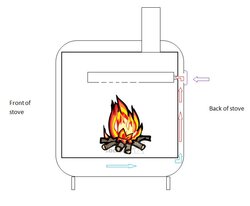I bought a new stove since I moved into a new house. I bought the identical one to which I had before since it was value for money and the design was ok.
I noticed when I installed the new one that it had an additional vent at the back, in line with the secondary air inlet. The previous one did not have this. On the previous stove, the air was sucked from the floor, via the metal jacket and into the secondary inlet. This pre-heated the air.
On the new one, cold air is sucked in via the new vent into the secondary combustion baffle plate and only then heated.
I noticed during the 1st week of running the stove that it was not as efficient as the old one with lots more smoke from the chimney.
So today, being a rainy Sunday, I stuck a piece of sheet metal with high temperature silicone over the vent. Within 10 mins I noticed the improved glow in the stove, with less smoke out the chimney. I managed to run the stove at 40% primary air compared to 100%.
Am I missing something or did I actually improve the stove's function? Surely I am not supposed to improve a design with a small piece of sheet metal while some guys in white coats spent years designing it?
I noticed when I installed the new one that it had an additional vent at the back, in line with the secondary air inlet. The previous one did not have this. On the previous stove, the air was sucked from the floor, via the metal jacket and into the secondary inlet. This pre-heated the air.
On the new one, cold air is sucked in via the new vent into the secondary combustion baffle plate and only then heated.
I noticed during the 1st week of running the stove that it was not as efficient as the old one with lots more smoke from the chimney.
So today, being a rainy Sunday, I stuck a piece of sheet metal with high temperature silicone over the vent. Within 10 mins I noticed the improved glow in the stove, with less smoke out the chimney. I managed to run the stove at 40% primary air compared to 100%.
Am I missing something or did I actually improve the stove's function? Surely I am not supposed to improve a design with a small piece of sheet metal while some guys in white coats spent years designing it?



